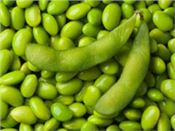|
One Step Closer To Commercial Edamame Production In The US

URBANA, ILL.
Edamame, touted as a healthy snack for its high protein content, is becoming increasingly popular in the United States. The soybean seeds are consumed at an immature stage, giving a sweet and slightly nutty flavor. Yet, despite the fact that grain soybean is grown on approximately 74 million acres in the U.S., the majority of edamame consumed here is imported from Asia. Part of the problem is that production practices, including weed control options, have not been well researched. A new University of Illinois study sheds light on weed management in edamame, bringing the crop one step closer to domestic cultivation.
“Vegetable processors identify weed interference as a major limitation to domestic edamame production on a commercial scale,” says U of I crop scientist and USDA-ARS ecologist Martin Williams.
Hand weeding is an expensive option, as labor costs can approach $500 per acre. And until recently, very few chemical weed control applications were available for use with edamame. An earlier study examining the effects of several herbicides registered for grain soybean confirmed that edamame lines were no more susceptible to injury from those herbicides than grain soybean. That study provided evidence that led to the EPA registering new chemicals yearly since 2012.
As Williams notes, “Effective weed management isn’t about applying one herbicide, and saying ’problem solved.’ It requires a multitude of integrated tactics, including a combination of herbicide active ingredients.”
The study examined the effects of eight treatments using herbicides applied both pre- and post-emergence, plus a weed-free control and a non-treated control. Registered herbicides clethodim, imazamox, linuron, trifluralin, and S-metolachlor were tested, along with two additional herbicides, imazethapyr and saflufenacil. The researchers measured weed biomass and edamame yield in all treatments, using three different edamame cultivars: IA1010, Butterbean, and Gardensoy 43, which was developed at U of I.
“All weed management treatments increased marketable pod yield relative to the non-treated control, but S-metolachlor with a follow-up application of imazamox had among the highest yield and lowest weed biomass without crop injury.”
Since these experiments were initiated, two additional herbicides have been registered (bentazon and fomesafen) and more are being considered.
The three edamame cultivars differed in their ability to compete with weeds. Gardensoy 43, which had the greatest pod yield of the three, also appeared to be the most competitive. In fact, weed biomass was 29 percent lower with Gardensoy 43 than the other cultivars.
The difference in cultivars is promising for all farmers, particularly those interested in weed control using fewer chemicals. In the future, breeders could potentially develop cultivars with even greater tolerance to weed interference. But cultivar improvement is just one piece of the puzzle.
“As part of an integrated system including inter-row cultivation, using cultivars that are more competitive, and using some of the more effective chemical treatments as a package, we are removing weed interference as a barrier to domestic edamame production,” Williams says.
“Managing Weeds in Commercial Edamame Production: Current Options and Implications,” authored by Martin Williams, appears in Weed Science. Funding was provided by the U.S. Department of Agriculture – Agricultural Research Service.
The article is available online at http://www.bioone.org/doi/pdf/10.1614/WS-D-15-00027.1 . ∆
|
|